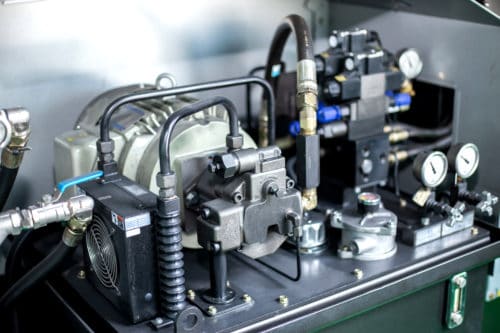Hydraulic systems use compressed hydraulic fluid to create and distribute the power needed to drive or move connected equipment. They are integrated into the devices and systems of a wide range of industries and applications, from aircraft doors in the aerospace industry to production machines in the manufacturing sector.
While the design and construction of hydraulic systems may vary to suit the specific needs of an application, all units operate under the same basic principle—i.e., force applied at one point will be transmitted through the hydraulic fluid to another point (note: for this principle to hold true, the fluid utilized must be incompressible, which means it should not change in volume when it is compressed). Additionally, they have the same key mechanical components: a hydraulic pump, a hydraulic motor or cylinder, and plumbing. Below, we provide an overview of these three components.
Hydraulic Pumps

In hydraulic systems, pumps are used to apply pressure to the hydraulic fluid. There are many types of hydraulic pumps available, each of which offers unique characteristics that make them suitable for different applications. For example:
- Gear pumps utilize meshing gears to pump a fixed amount of fluid per rotation. They are best suited for low-pressure hydraulic systems (under 1,500 psi).
- Piston pumps use a piston within a cylinder to move fluid. They are available in fixed displacement and variable displacement variations; the former move a specific amount of fluid per stroke, while the latter alter fluid output to compensate for changes in system demand.
These pumps can be powered in a variety of ways, including:
- Manual: the pump is powered manually (e.g., by human-operated pedals or hand levers)
- Engine driven: the pump is mounted on the engine accessory gearbox
- Electric: the pump is powered by an AC or DC motor
- Pneumatic: the pump is powered by air-powered motors
- Hydraulic: the pump is powered by another hydraulic system via a power transfer unit (PTU)
- Ram Air Turbine (RAT): the pump is powered by a ram air turbine that extends into the airstream to produce hydraulic pressure
Hydraulic Motors and Cylinders
Once the pump has pressurized the hydraulic fluid, hydraulic motors and cylinders use the pressurized fluid to perform mechanical work.
- Hydraulic motors convert the hydraulic pressure and flow into torque and angular displacement or rotation. They are available in numerous variations, including gear, vane, and radial piston.
- Hydraulic cylinders provide reversible force in one direction. They consist of a piston connected to a piston rod inside of a cylinder. The hydraulic pressure moves the piston and piston rod back and forth within the cylinder.
Plumbing Components for Hydraulic Systems
The plumbing ensures the hydraulic fluid moves through the hydraulic system as needed. It consists of a variety of components that perform different functions, including:
- Reservoir: holds the amount of hydraulic fluid necessary to operate the hydraulic system
- Hydraulic filters and strainers: removes contaminants from the hydraulic fluid that could compromise the functionality and reliability of the hydraulic system
- Shut-off valves: serves as a safety measure that prevents the ignition of the hydraulic fluid
- Control valves: controls the directional flow of the pressurized hydraulic fluid
- Pressure relief valves: ensures the hydraulic system does not exceed the nominal system pressure
- Hydraulic fuses: automatically seals off the hydraulic line if pressure drops below a certain threshold
- Accumulators: stores pressurized hydraulic fluid that can be used to quickly and temporarily supplement force in the system in the event of sudden high demand or pump failure
Learn More About Hydraulic Components From DOMS Incorporated
From pumps to motors and cylinders to plumbing, each component within a hydraulic system is essential to achieving smooth and reliable system operation. To learn more about these components and their functions, contact the hydraulic equipment experts at DOMS Incorporated today. If you need components for a hydraulic system, request a quote.




